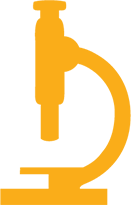Camp Yellow Scope: Sugars & Syrups

Howdy Campers!
Welcome to Week 7 of Camp Yellow Scope. Time sure goes by fast when you're having fun, right?! Click here to download printable instructions. You can also print out a lab worksheet to record your observations, jot down ideas, and design your own experiments! If you collect your worksheets together from all eight weeks, by the end of the summer you’ll have your very own Camp Yellow Scope notebook! You can even add some extra sheets for new experiments you design yourself.
Experiment 1: Liquid Rainbow

You’ve probably used crayons or paint to draw rainbows on paper. How would you like to make a liquid rainbow? In this week’s experiments, we’ll try to stack different colored liquids on top of each other.
The trick to stacking liquids depends on a property called density. Density refers to how much stuff can be packed in a given space. Scientists call the “stuff”, mass and the “space”, volume. To change the density of a liquid you can add more stuff (or mass) to a given volume. In our experiments this week, we are going to make solutions of sugar water that have different densities. Adding more sugar to given volume of water will increase the density of the water.
Let’s get started
Are you ready to make a liquid rainbow? All you need is sugar, water, and some food coloring. Clear a space and get ready to have fun while doing science!
Hypothesis
What do you think will happen when you add plain water on top of sugar water? Will the two liquids mix? Write down your hypotheses in your lab worksheet.
Instructions

- Put on your safety goggles.
- Add 1 cup of tap water (not too cold) to each of the 2 cups/glasses.
- Color each cup of water a different color with a few drops of food coloring. (Make one yellow and one blue, for example.)
- Label one of the cups “Water” and set aside.
- To the second cup, add 8 teaspoons of sugar. Stir until all the sugar is dissolved. Label this cup “Sugar Water”.
- Now place the clear narrow glass on a flat surface.
- Carefully pour some of the “Sugar Water” into the glass.
- Let the sugar water settle.
- Now you are going to try to carefully try stack the plain colored water from the “Water” cup on top of the sugar water. To do this, use the medicine dropper to slowly and carefully transfer some of the “Water” to the glass on top of the “Sugar Water”. Keep adding the “Water” until you can see a nice band of color on top of the “Sugar Water”.
- Draw what you see on your lab worksheet.
Congratulations, Campers, you made the beginning of a liquid rainbow!
What’s Happening?
Why did the plain water stack on top of the sugar water instead of mixing in? To understand this, let’s talk more about density.
Consider what was in each cup:
- The first cup (“Water”) just had 1 cup of water.
- The second cup (“Sugar Water”) had 1 cup of water plus 8 teaspoons of sugar.
Which liquid has a higher density? Right – the sugar water in the second cup is more dense. The volume was the same in both cases (1 cup) but the sugar increased the mass, and therefore the density, in the second cup.
Liquids that are more dense are heavier and will sink lower. Liquids that are less dense are lighter and will stay on top. In these experiments, the more dense sugar water was on the bottom and the less dense plain water was on the top.


Why does it matter?
Can you think of everyday examples where density plays an important role?
- If we know the density of an object, we can predict if it will sink or float in water. Engineers design ships so that they are less dense than water and therefore can float!
- Oil is less dense than water and so floats on it. This makes cleaning up an oil spill in ocean a bit easier.
- Helium balloons float up in the air because helium gases is less dense than air.
You own it!
True or False:
- Oil is heavier than water.
- If an object is denser than water, it will sink.
- Density = Mass + Volume.
Answer key:
1. False. Oil is lighter than water and that’s why it floats on top.2. True.
3. False. Density = Mass / Volume.

We hope you had fun making liquid rainbows using science! Next week we will try to make better bubbles. Sounds exciting?! Check back next Tuesday for more summer science fun.
We'd love to see how your experiments turned out! Share your photos or videos:
- Facebook: Yellow Scope Science Kits for Girls
- Twitter: @YellowScopeGirl, #CampYellowScope
- email: info@yellow-scope.com



Yellow Scope
Author